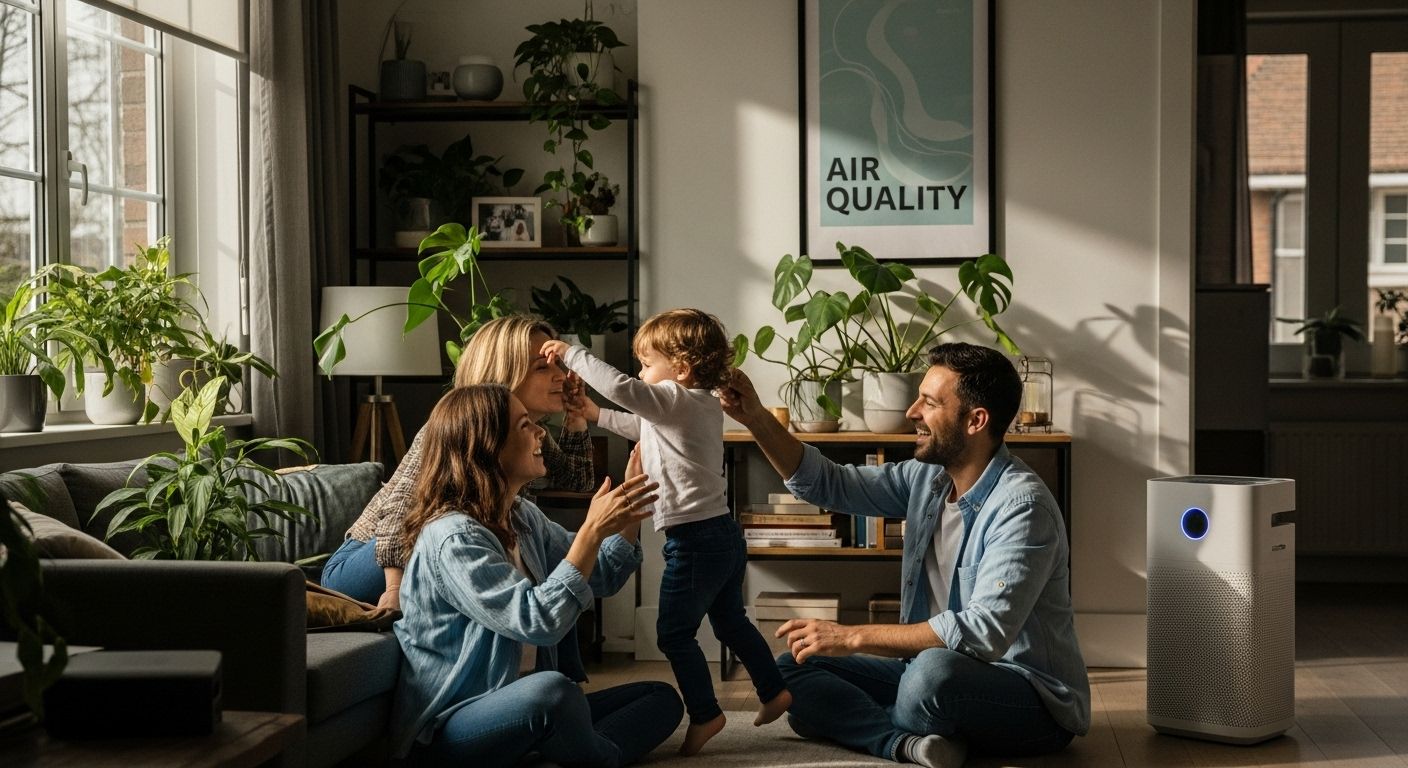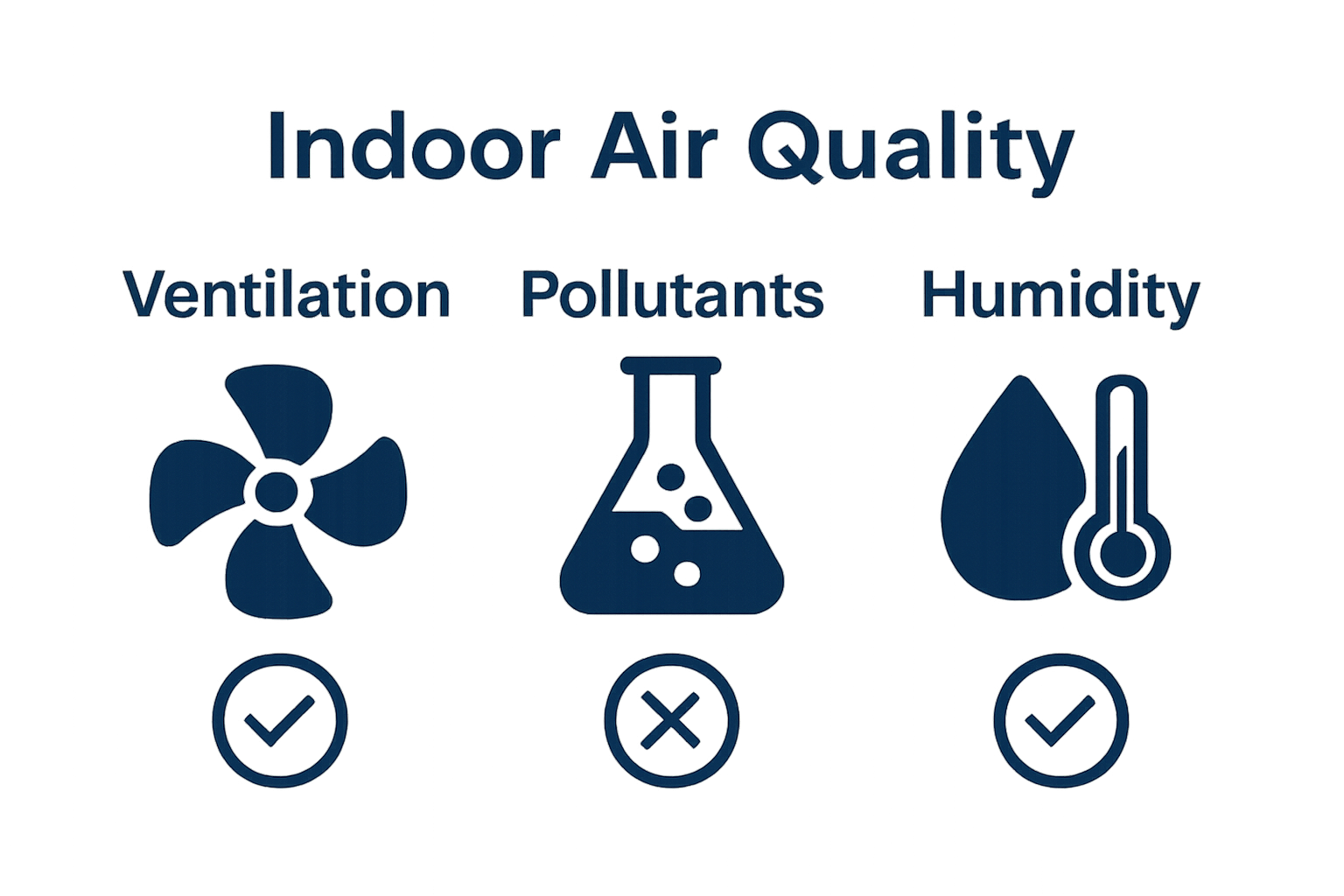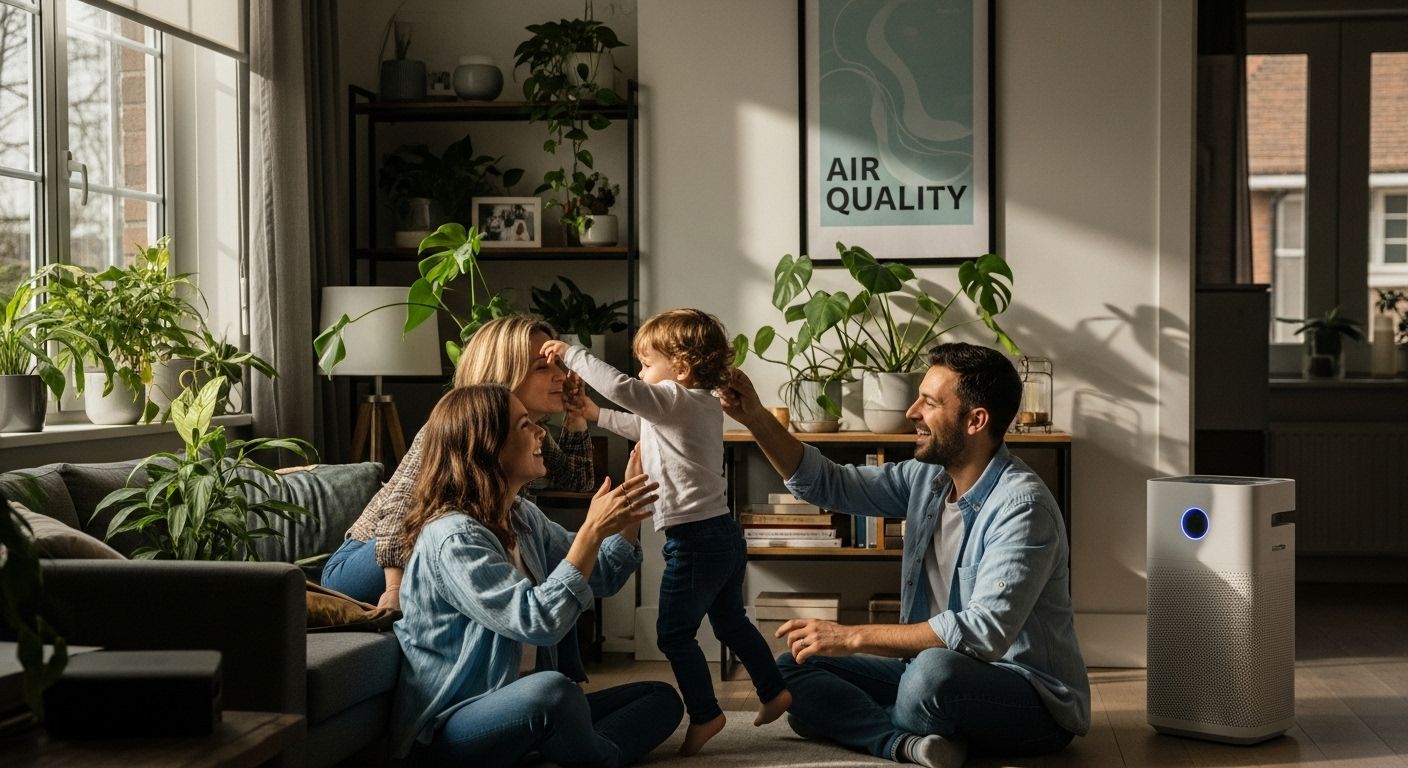
Indoor air quality shapes how we live, work, and feel every single day. Most people assume outdoor smog is the main concern, but indoors can be even more hazardous. The surprising truth is that people spend around 90 percent of their time inside and indoor air often carries higher pollution levels than what’s outside, making the air in our homes and workplaces far more impactful on our health than most realize.
Table of Contents
- What Is Indoor Air Quality And Why Is It Important?
- The Impact Of Poor Indoor Air Quality On Health And Well-Being
- Factors That Affect Indoor Air Quality In Various Settings
- The Role Of Ventilation And Filtration In Maintaining Air Quality
- Understanding Indoor Air Quality Standards And Best Practices
Quick Summary
| Takeaway | Explanation |
|---|---|
| Indoor air quality critically affects health. | Poor indoor air quality can lead to immediate health issues and long-term complications for occupants. |
| Vulnerable groups are at greater risk. | Children, the elderly, and individuals with pre-existing health conditions suffer more from poor indoor air quality. |
| Ventilation is essential for improvement. | Effective ventilation introduces fresh air and removes contaminants, helping to enhance indoor air quality. |
| Regular monitoring is necessary. | Continuously assessing air quality helps identify pollutants and ensures a healthy indoor environment. |
| Compliance with standards ensures safety. | Adhering to established indoor air quality guidelines protects health and promotes well-being across various settings. |
What is Indoor Air Quality and Why is it Important?
Indoor air quality (IAQ) represents the overall condition of the air within buildings and structures that directly impacts human health, comfort, and performance. Research from the Environmental Protection Agency indicates that people spend approximately 90% of their time indoors, making the quality of indoor air critically significant.
Understanding Indoor Air Composition
Indoor air is a complex mixture of gases, particles, and biological materials that can originate from multiple sources. These include:
- Building materials and furnishings
- Human activities and occupancy
- Outdoor air pollution infiltrating indoor spaces
- Heating and cooling systems
- Cleaning products and personal care items
The composition of indoor air can dramatically differ from outdoor environments, often containing higher concentrations of pollutants that can negatively affect respiratory health and overall well-being.
Health and Productivity Implications
Research published in Environmental Health Perspectives revealed compelling evidence about the profound impact of indoor air quality on human cognitive performance. Studies demonstrate that poor air quality can lead to reduced cognitive function, slower response times, and decreased workplace productivity.
Poor indoor air quality can trigger various health issues, ranging from immediate short-term effects like headaches and fatigue to long-term complications such as respiratory diseases, cardiovascular problems, and potential neurological impacts. Vulnerable populations including children, elderly individuals, and those with pre-existing health conditions are particularly susceptible to indoor air quality challenges.

Understanding and managing indoor air quality is not just a health imperative but also a critical factor in creating safe, comfortable, and high-performing indoor environments across residential, commercial, and industrial settings.
The Impact of Poor Indoor Air Quality on Health and Well-being
Poor indoor air quality represents a significant yet often overlooked health risk that can generate immediate and long-term consequences for human wellness. Research from the Environmental Protection Agency highlights that indoor air pollution levels can be substantially higher than outdoor environments, creating potential health challenges across various population segments.
Respiratory and Cardiovascular Consequences
Indoor air pollutants can trigger and exacerbate numerous respiratory conditions. Nitrogen dioxide, carbon monoxide, and particulate matter contribute to complex health risks that extend beyond simple breathing difficulties. Specific respiratory impacts include:
- Increased asthma attack frequency
- Reduced lung function capacity
- Higher susceptibility to respiratory infections
- Chronic inflammation of respiratory passages
People with pre-existing conditions such as chronic obstructive pulmonary disease (COPD) or cardiovascular issues are particularly vulnerable to these indoor environmental challenges.
Neurological and Cognitive Performance Effects
Research published in Environmental Health Perspectives demonstrates that poor indoor air quality significantly impacts cognitive performance. Elevated levels of particulate matter and carbon dioxide can diminish mental acuity, reduce decision-making capabilities, and decrease overall workplace productivity.
Chronic exposure to indoor air pollutants has been associated with potential neurological complications, including:
- Decreased cognitive processing speed
- Reduced concentration and attention span
- Increased risk of developing neurodegenerative conditions
- Potential long-term memory function impairment
Understanding these risks underscores the critical importance of maintaining high-quality indoor air environments across residential, commercial, and industrial settings.
Preventing and mitigating indoor air quality challenges requires a comprehensive approach involving proper ventilation, regular air quality monitoring, and strategic reduction of potential pollutant sources. Professional assessment and targeted interventions can significantly minimize health risks associated with indoor air pollution.
Factors That Affect Indoor Air Quality in Various Settings
Indoor air quality is a dynamic system influenced by multiple interconnected environmental and human factors. Research from the Environmental Protection Agency reveals that the complexity of indoor air quality extends far beyond simple ventilation considerations.
Source-Based Pollutant Generators
Indoor environments harbor numerous pollutant sources that can significantly compromise air quality. These sources vary dramatically across different settings and include:
- Building materials and furnishings
- Heating and cooling systems
- Personal care and cleaning products
- Cooking appliances
- Electronic devices and office equipment
Each source contributes unique chemical compounds and particulate matter that interact within indoor spaces, creating a complex air quality ecosystem. The concentration and interaction of these pollutants determine the overall environmental health of an indoor setting.
Structural and Environmental Influences
Research from the National Academies emphasizes that building characteristics play a critical role in indoor air quality management. Key structural factors include:
- Building age and construction materials
- Ventilation system design and maintenance
- Humidity and temperature levels
- Proximity to outdoor pollution sources
- Occupancy density and usage patterns
These environmental elements interact dynamically, creating unique air quality profiles for residential, commercial, and industrial spaces. Older buildings might have higher concentrations of legacy pollutants, while newer constructions could introduce volatile organic compounds from modern materials.
Understanding these multifaceted interactions is crucial for developing effective indoor air quality management strategies. Comprehensive approaches must consider the intricate relationships between human activities, structural characteristics, and environmental conditions to create healthier indoor environments.
The Role of Ventilation and Filtration in Maintaining Air Quality
Ventilation and filtration represent critical technological interventions that actively manage and improve indoor air quality across diverse environments. Research from the Centers for Disease Control and Prevention highlights the fundamental importance of strategic air management in reducing potential health risks.
Ventilation Principles and Strategies
Ventilation serves as the primary mechanism for introducing fresh outdoor air and removing contaminated indoor air. Effective ventilation strategies involve multiple approaches:
- Natural ventilation through windows and architectural design
- Mechanical ventilation using HVAC systems
- Hybrid ventilation combining multiple air exchange methods
- Targeted ventilation in specific high-risk or high-traffic areas
The goal of ventilation extends beyond simple air replacement, focusing on creating dynamic air circulation that minimizes pollutant accumulation. Different settings require customized ventilation approaches that consider occupancy, activity levels, and specific environmental challenges.
Filtration Technologies and Performance
Research from the Environmental Protection Agency demonstrates that filtration technologies play a crucial role in removing particulate matter and potential contaminants. Air filtration systems are evaluated using MERV (Minimum Efficiency Reporting Value) ratings, which indicate their capacity to capture particles of varying sizes:
This table compares the various Minimum Efficiency Reporting Value (MERV) ratings referenced in the article, summarizing their effectiveness at filtering particles of different sizes.
| MERV Rating Range | Particle Size Captured | Example Contaminants Removed |
|---|---|---|
| 1-4 | Large particles | Pollen, dust mites, carpet fibers |
| 5-8 | Medium and smaller particles | Mold spores, pet dander |
| 9-12 | Fine particles | Bacteria, lead dust, milled flour |
| 13-16 | Very fine particles | Viruses, smoke, sneeze droplets |
- MERV 1-4: Captures larger particles
- MERV 5-8: Traps smaller particles like mold spores
- MERV 9-12: Removes fine particles including bacteria
- MERV 13-16: Captures extremely small particles and potential viral carriers
Advanced filtration technologies, such as HEPA filters, can remove up to 99.97% of airborne particles as small as 0.3 microns, providing significant improvements in indoor air quality.
Comprehensive indoor air quality management requires an integrated approach that combines strategic ventilation, advanced filtration technologies, and continuous monitoring to create healthier indoor environments across residential, commercial, and industrial settings.
Understanding Indoor Air Quality Standards and Best Practices
Indoor air quality standards represent critical guidelines that establish minimum requirements for maintaining healthy and safe indoor environments. Research from the American Society of Heating, Refrigerating and Air-Conditioning Engineers (ASHRAE) provides comprehensive frameworks for evaluating and managing air quality across different settings.
Regulatory Frameworks and Measurement Standards
Indoor air quality standards encompass a complex network of guidelines that address multiple environmental factors. These standards focus on several key dimensions:
- Ventilation rate requirements
- Acceptable pollutant concentration levels
- Humidity and temperature control
- Particulate matter filtration efficiency
- Minimum air exchange recommendations
Regulatory bodies establish these standards to protect human health by defining acceptable parameters for indoor environmental conditions. Different sectors such as healthcare, education, commercial spaces, and residential buildings have unique standards tailored to their specific requirements.

Compliance and Implementation Strategies
Research from ASHRAE Standard 241 introduces innovative approaches to managing indoor air quality. The standard establishes minimum requirements for reducing disease transmission risks through advanced air management techniques:
- Establishing equivalent clean airflow rate targets
- Implementing infection risk management modes
- Utilizing advanced filtration and air-cleaning technologies
- Developing comprehensive building readiness plans
Effective implementation requires a holistic approach that combines technological solutions, regular monitoring, and proactive maintenance strategies. Organizations must continuously assess and adapt their indoor air quality management protocols to address evolving environmental and health challenges.
Comprehensive indoor air quality management transcends simple compliance, representing a critical investment in occupant health, productivity, and overall environmental well-being.
Take Control of Indoor Air Quality with the Right Floor Mats
If you are concerned about the hidden dangers of poor indoor air quality, you are not alone. The article highlights how invisible particulates and harmful pollutants easily build up in high-traffic areas, often entering from shoes and external sources. Commercial and industrial properties see even higher risks because contaminants can be tracked inside all day and accumulate on your floors. This can result in compromised air quality throughout your facility, affecting the health, comfort, and productivity of everyone who enters.
There is a simple yet highly effective way to start making your indoor environment safer right now. Installing premium floor mats from Mats4U.com actively reduces the transfer of dust, debris, and particles that would otherwise circulate through your air. Whether you need entrance mats, specialized anti-fatigue options, or branded solutions, you will find tough, easy-to-clean products designed for demanding spaces. Explore our full range of commercial and industrial mats on our product selection page and experience how proactive flooring solutions can support cleaner air and a healthier business environment. Protect your workspace today by choosing mats that work for you—visit Mats4U.com and give your indoor air quality the upgrade it deserves.
Frequently Asked Questions
What is indoor air quality and why is it important?
Indoor air quality (IAQ) refers to the condition of the air within buildings, which significantly impacts human health, comfort, and performance. Since people spend about 90% of their time indoors, maintaining high-quality indoor air is crucial for preventing health issues and promoting well-being.
What are the common sources of indoor air pollution?
Common sources of indoor air pollution include building materials, furniture, cleaning products, outdoor air infiltration, heating and cooling systems, and human activities. Each of these can contribute to higher concentrations of harmful pollutants in indoor settings.
How can poor indoor air quality affect health and productivity?
Poor indoor air quality can lead to various health issues, such as respiratory problems, headaches, and fatigue. It can also decrease cognitive performance, slowing response times and reducing productivity in workplaces. Vulnerable populations, like children and the elderly, are particularly at risk.
What strategies can improve indoor air quality?
Improving indoor air quality involves effective ventilation, using advanced filtration systems, and monitoring air quality regularly. Strategies such as natural or mechanical ventilation and implementing air purification technologies can significantly reduce indoor pollutants and enhance overall air quality.







